2009 BMW 330D traction control
[x] Cancel search: traction controlPage 17 of 268

At a glance
15Reference
Controls
Driving tips
Communications
Navigation
Entertainment
Mobility
1Microphone for voice activation system*
and for telephone in hands-free mode*
2SOS: initiating an Emergency Request
call
*230
3 Reading lamps 93
4 Glass roof/panorama glass roof
*37
5 Interior lamps 93
6 Passenger airbag status lamp
*89
7 Control Display 16
8 Hazard warning flashers
9 Dynamic Traction Control DTC 81
10 Central locking system 30
11 Automatic climate control
12 CD/DVD drive 150
13 Changing the audio and entertainment
sources
14 Selecting AM or FM waveband 15
Changing
>Radio station 145
> Track 150
17 Controller 16
Can be turned, pressed, or moved in four
directions
18 Buttons on the controller 16
Selecting menus directly
19 Programmable memory keys 20
20 Switching audio sources on/off and adjust-
ing volume 142
21 Ejecting CD/DVD 150
Air distribution to the
windshield
95
Air distribution to the upper body
area 95
Air distribution to the footwell 95
Automatic air distribution and flow
rate 95
Cooling function 96
Automatic recircul ated-air control
AUC 96
Recirculated-air mode 96
Maximum cooling 95
Residual heat mode 96
Air flow rate 95
Defrosting windows 96
Rear window defroster 97
16
Heated seats*45
Park Distance Control PDC
*80
Sedan:
Roller sun blind
*102
Hill Descent Control HDC
*82
ba8_E9091_cic.book Seite 15 Mittwoch, 29. Oktober 2008 2:59 14
Page 83 of 268
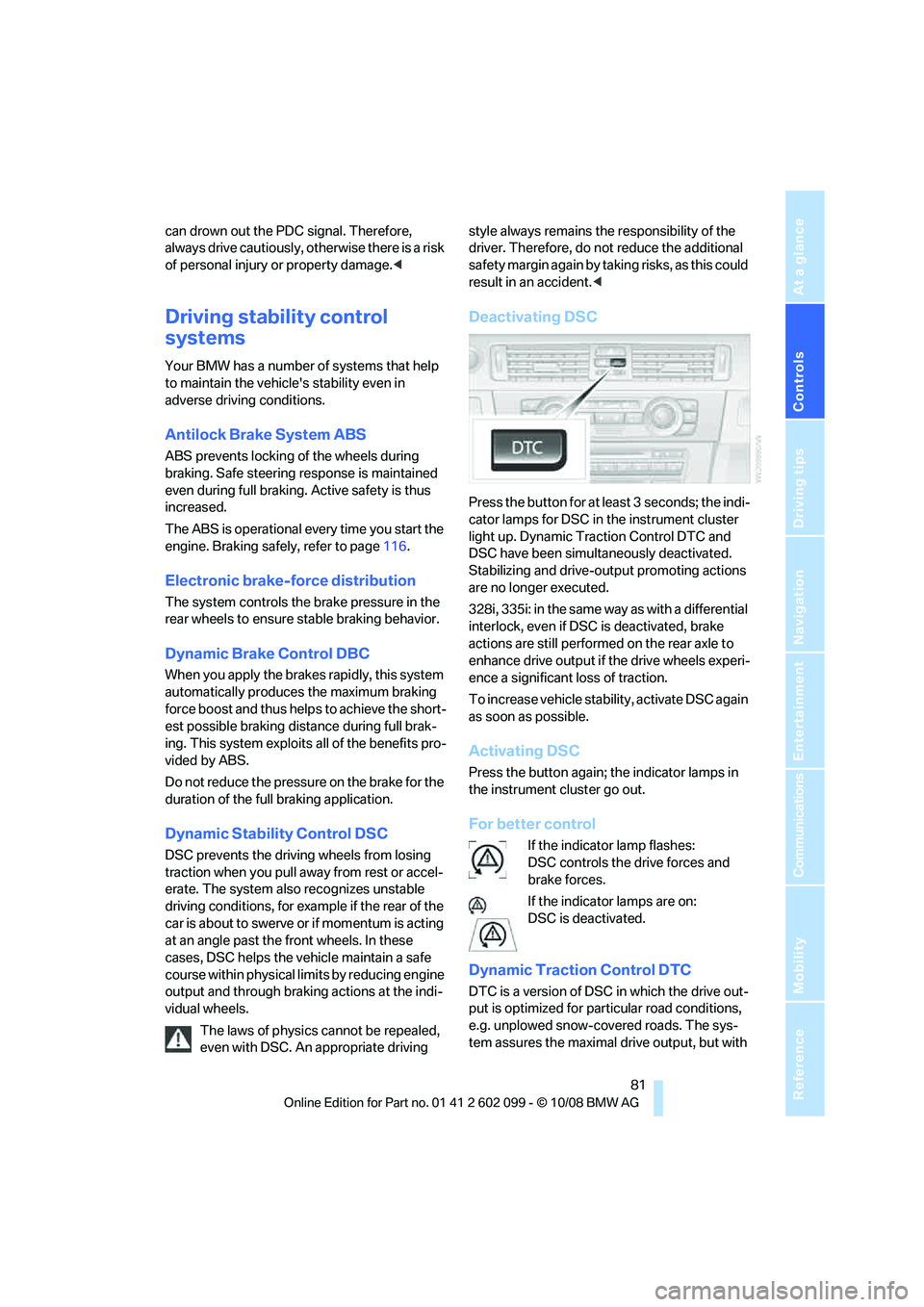
Controls
81Reference
At a glance
Driving tips
Communications
Navigation
Entertainment
Mobility
can drown out the PDC signal. Therefore,
always drive cautiously, otherwise there is a risk
of personal injury or property damage.<
Driving stability control
systems
Your BMW has a number of systems that help
to maintain the vehicle's stability even in
adverse driving conditions.
Antilock Brake System ABS
ABS prevents locking of the wheels during
braking. Safe steering response is maintained
even during full braking. Active safety is thus
increased.
The ABS is operational every time you start the
engine. Braking safely, refer to page 116.
Electronic brake-force distribution
The system controls the brake pressure in the
rear wheels to ensure stable braking behavior.
Dynamic Brake Control DBC
When you apply the brakes rapidly, this system
automatically produces the maximum braking
force boost and thus help s to achieve the short-
est possible braking distance during full brak-
ing. This system exploits all of the benefits pro-
vided by ABS.
Do not reduce the pressure on the brake for the
duration of the full braking application.
Dynamic Stability Control DSC
DSC prevents the driving wheels from losing
traction when you pull away from rest or accel-
erate. The system also recognizes unstable
driving conditions, for example if the rear of the
car is about to swerve or if momentum is acting
at an angle past the front wheels. In these
cases, DSC helps the ve hicle maintain a safe
course within physical lim its by reducing engine
output and through braking actions at the indi-
vidual wheels.
The laws of physics cannot be repealed,
even with DSC. An appropriate driving style always remains the responsibility of the
driver. Therefore, do not reduce the additional
s a f e t y m a r g i n a g a i n b y t a k i n g r i s k s , a s t h i s c o u l d
result in an accident.
<
Deactivating DSC
Press the button for at least 3 seconds; the indi-
cator lamps for DSC in the instrument cluster
light up. Dynamic Traction Control DTC and
DSC have been simultaneously deactivated.
Stabilizing and drive-output promoting actions
are no longer executed.
328i, 335i: in the same way as with a differential
interlock, even if DSC is deactivated, brake
actions are still performed on the rear axle to
enhance drive output if the drive wheels experi-
ence a significant loss of traction.
To increase vehicle stability, activate DSC again
as soon as possible.
Activating DSC
Press the button again; the indicator lamps in
the instrument cluster go out.
For better control
If the indicator lamp flashes:
DSC controls the drive forces and
brake forces.
If the indicator lamps are on:
DSC is deactivated.
Dynamic Traction Control DTC
DTC is a version of DSC in which the drive out-
put is optimized for particular road conditions,
e.g. unplowed snow-covered roads. The sys-
tem assures the maximal drive output, but with
ba8_E9091_cic.book Seite 81 Mittwoch, 29. Oktober 2008 2:59 14
Page 84 of 268
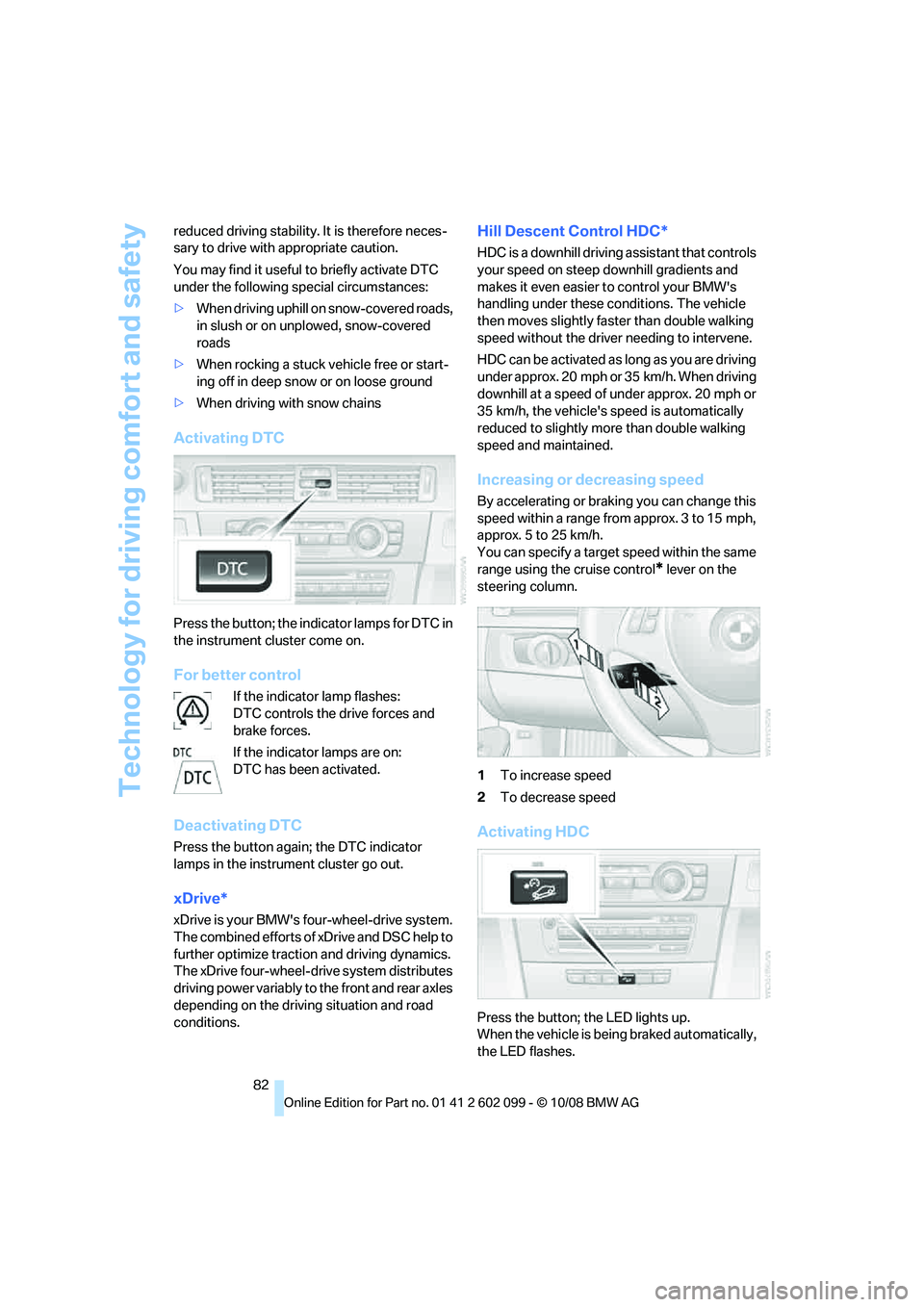
Technology for driving comfort and safety
82
reduced driving stability. It is therefore neces-
sary to drive with appropriate caution.
You may find it useful
to briefly activate DTC
under the following sp ecial circumstances:
> When driving uphill on snow-covered roads,
in slush or on unplowed, snow-covered
roads
> When rocking a stuck vehicle free or start-
ing off in deep snow or on loose ground
> When driving with snow chains
Activating DTC
Press the button; the indicator lamps for DTC in
the instrument cluster come on.
For better control
If the indicator lamp flashes:
DTC controls the drive forces and
brake forces.
If the indicator lamps are on:
DTC has been activated.
Deactivating DTC
Press the button again; the DTC indicator
lamps in the instrument cluster go out.
xDrive*
xDrive is your BMW's four-wheel-drive system.
The combined efforts of xDrive and DSC help to
further optimize traction and driving dynamics.
The xDrive four-wheel-drive system distributes
driving power variably to the front and rear axles
depending on the driving situation and road
conditions.
Hill Descent Control HDC*
HDC is a downhill driving assistant that controls
your speed on steep downhill gradients and
makes it even easier to control your BMW's
handling under these conditions. The vehicle
then moves slightly faster than double walking
speed without the driver needing to intervene.
HDC can be activated as long as you are driving
under approx. 20 mph or 35 km/h. When driving
downhill at a speed of under approx. 20 mph or
35 km/h, the vehicle's speed is automatically
reduced to slightly more than double walking
speed and maintained.
Increasing or decreasing speed
By accelerating or brak ing you can change this
speed within a range from approx. 3 to 15 mph,
approx. 5 to 25 km/h.
You can specify a target speed within the same
range using the cruise control
* lever on the
steering column.
1 To increase speed
2 To decrease speed
Activating HDC
Press the button; the LED lights up.
When the vehicle is being braked automatically,
the LED flashes.
ba8_E9091_cic.book Seite 82 Mittwoch, 29. Oktober 2008 2:59 14
Page 209 of 268
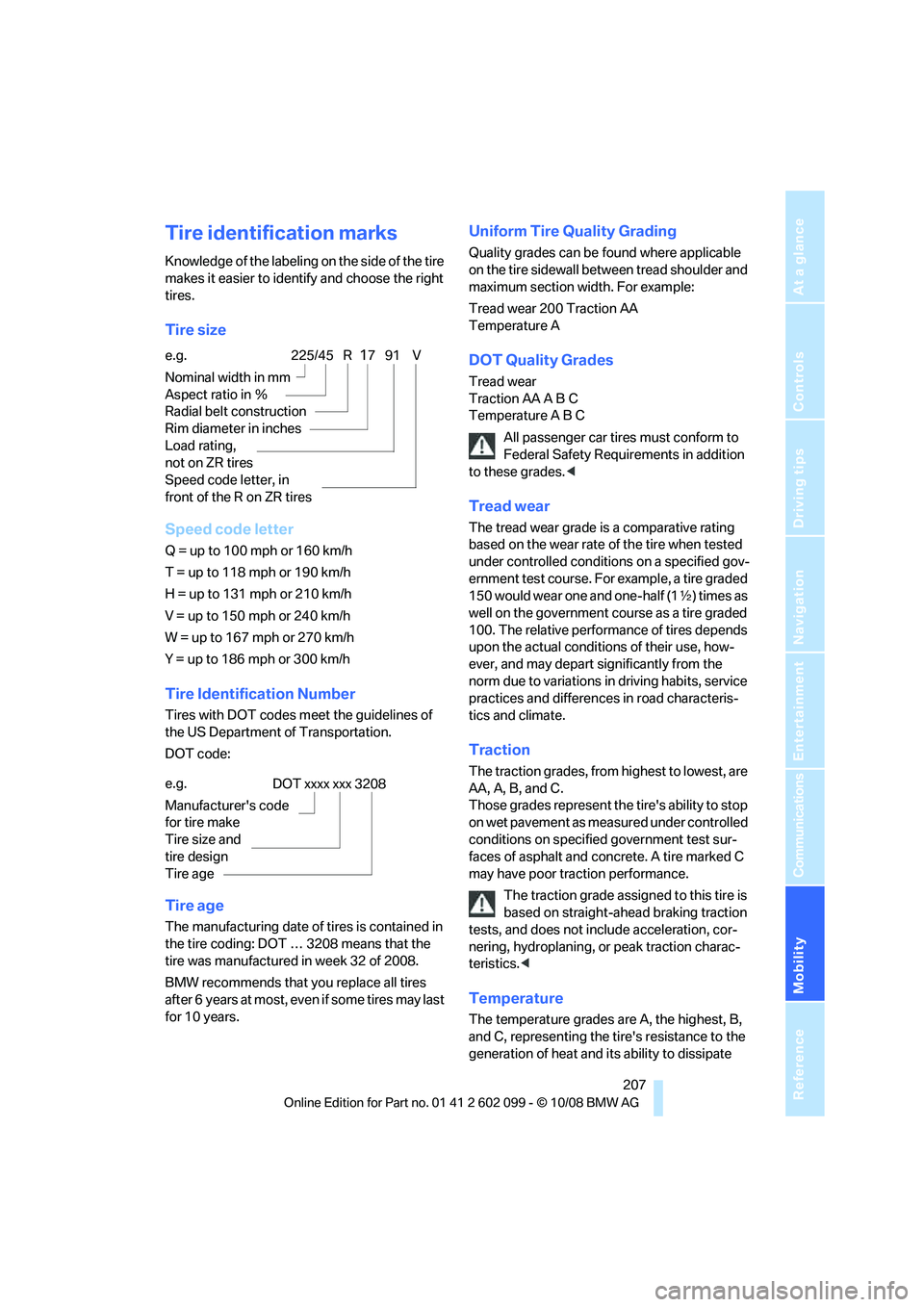
Mobility
207Reference
At a glance
Controls
Driving tips
Communications
Navigation
Entertainment
Tire identification marks
Knowledge of the labeling on the side of the tire
makes it easier to identify and choose the right
tires.
Tire size
Speed code letter
Q = up to 100 mph or 160 km/h
T = up to 118 mph or 190 km/h
H = up to 131 mph or 210 km/h
V = up to 150 mph or 240 km/h
W = up to 167 mph or 270 km/h
Y = up to 186 mph or 300 km/h
Tire Identification Number
Tires with DOT codes meet the guidelines of
the US Department of Transportation.
DOT code:
Tire age
The manufacturing date of tires is contained in
the tire coding: DOT … 3208 means that the
tire was manufactured in week 32 of 2008.
BMW recommends that you replace all tires
after 6 years at most, even if some tires may last
for 10 years.
Uniform Tire Quality Grading
Quality grades can be found where applicable
on the tire sidewall between tread shoulder and
maximum section width. For example:
Tread wear 200 Traction AA
Temperature A
DOT Quality Grades
Tread wear
Traction AA A B C
Temperature A B C
All passenger car tires must conform to
Federal Safety Requir ements in addition
to these grades. <
Tread wear
The tread wear grade is a comparative rating
based on the wear rate of the tire when tested
under controlled conditio ns on a specified gov-
ernment test course. For example, a tire graded
150 would wear one and one-half (1 γ) times as
well on the government course as a tire graded
100. The relative performance of tires depends
upon the actual conditions of their use, how-
ever, and may depart significantly from the
norm due to variations in driving habits, service
practices and differences in road characteris-
tics and climate.
Traction
The traction grades, from highest to lowest, are
AA, A, B, and C.
Those grades represent the tire's ability to stop
on wet pavement as measured under controlled
conditions on specified government test sur-
faces of asphalt and concrete. A tire marked C
may have poor traction performance.
The traction grade assigned to this tire is
based on straight-ahe ad braking traction
tests, and does not in clude acceleration, cor-
nering, hydroplaning, or peak traction charac-
teristics. <
Temperature
The temperature grades ar e A, the highest, B,
and C, representing the ti re's resistance to the
generation of heat and its ability to dissipate
e.g.
Nominal width in mm
Aspect ratio in Ξ
Radial belt construction
Rim diameter in inches
Load rating,
not on ZR tires
Speed code letter, in
front of the R on ZR tires225/45 R1791 V
e.g.
Manufacturer's code
for tire make
Tire size and
tire design
Tire ageDOT xxxx xxx 3208
ba8_E9091_cic.book Seite 207 Mittwoch, 29. Oktober 2008 2:59 14
Page 256 of 268
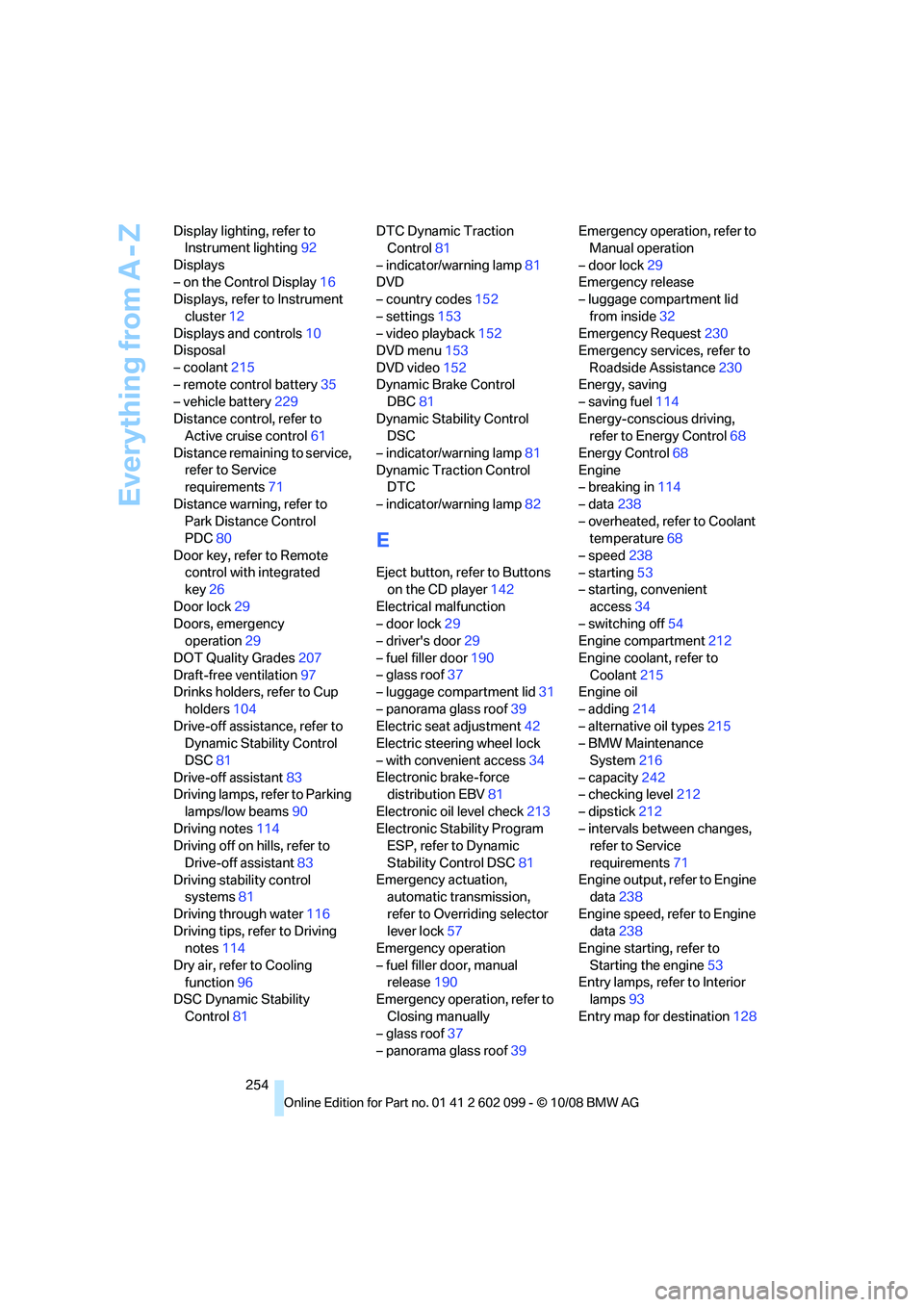
Everything from A - Z
254
Display lighting, refer to
Instrument lighting 92
Displays
– on the Control Display 16
Displays, refer to Instrument
cluster 12
Displays and controls 10
Disposal
– coolant 215
– remote control battery 35
– vehicle battery 229
Distance control, refer to Active cruise control 61
Distance remainin g to service,
refer to Service
requirements 71
Distance warning, refer to Park Distance Control
PDC 80
Door key, refer to Remote control with integrated
key 26
Door lock 29
Doors, emergency operation 29
DOT Quality Grades 207
Draft-free ventilation 97
Drinks holders, refer to Cup
holders 104
Drive-off assistance, refer to Dynamic Stability Control
DSC 81
Drive-off assistant 83
Driving lamps, refer to Parking
lamps/low beams 90
Driving notes 114
Driving off on hills, refer to
Drive-off assistant 83
Driving stability control systems 81
Driving through water 116
Driving tips, refer to Driving notes 114
Dry air, refer to Cooling function 96
DSC Dynamic Stability
Control 81 DTC Dynamic Traction
Control 81
– indicator/warning lamp 81
DVD
– country codes 152
– settings 153
– video playback 152
DVD menu 153
DVD video 152
Dynamic Brake Control DBC 81
Dynamic Stability Control DSC
– indicator/warning lamp 81
Dynamic Traction Control DTC
– indicator/warning lamp 82
E
Eject button, refer to Buttons
on the CD player 142
Electrical malfunction
– door lock 29
– driver's door 29
– fuel filler door 190
– glass roof 37
– luggage compartment lid 31
– panorama glass roof 39
Electric seat adjustment 42
Electric steering wheel lock
– with convenient access 34
Electronic brake-force distribution EBV 81
Electronic oil level check 213
Electronic Stability Program ESP, refer to Dynamic
Stability Control DSC 81
Emergency actuation, automatic transmission,
refer to Overriding selector
lever lock 57
Emergency operation
– fuel filler door, manual release 190
Emergency operation, refer to
Closing manually
– glass roof 37
– panorama glass roof 39Emergency operation, refer to
Manual operation
– door lock 29
Emergency release
– luggage compartment lid
from inside 32
Emergency Request 230
Emergency services, refer to
Roadside Assistance 230
Energy, saving
– saving fuel 114
Energy-conscious driving, refer to Energy Control 68
Energy Control 68
Engine
– breaking in 114
– data 238
– overheated, refer to Coolant temperature 68
– speed 238
– starting 53
– starting, convenient
access 34
– switching off 54
Engine compartment 212
Engine coolant, refer to Coolant 215
Engine oil
– adding 214
– alternative oil types 215
– BMW Maintenance
System 216
– capacity 242
– checking level 212
– dipstick 212
– intervals between changes, refer to Service
re
quirements 71
Engine output, refer to Engine data 238
Engine speed, refer to Engine data 238
Engine starting, refer to
Starting the engine 53
Entry lamps, refer to Interior lamps 93
Entry map for destination 128
ba8_E9091_cic.book Seite 254 Mittwoch, 29. Oktober 2008 2:59 14
Page 265 of 268
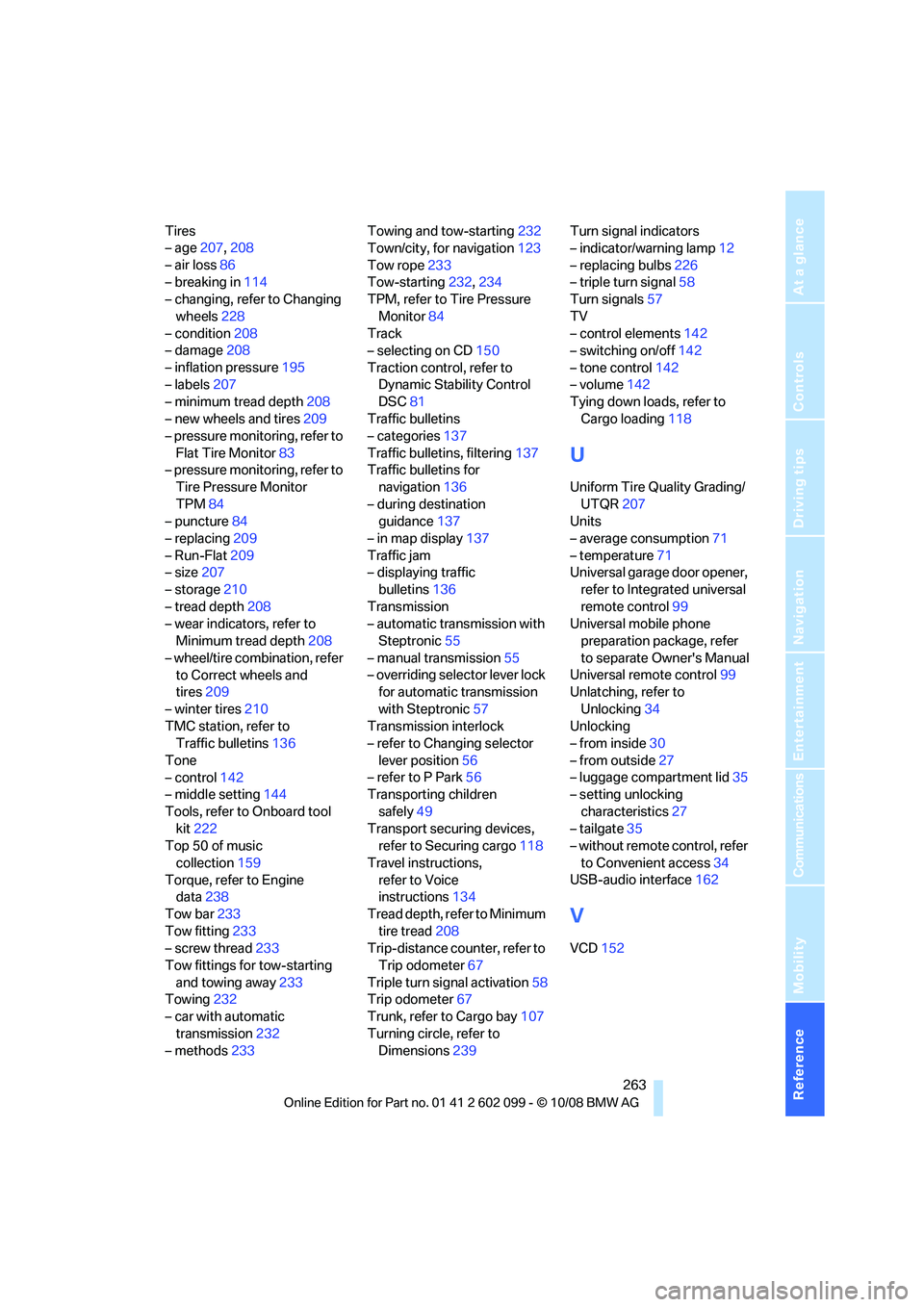
Reference 263
At a glance
Controls
Driving tips
Communications
Navigation
Entertainment
Mobility
Tires
– age207,208
– air loss 86
– breaking in 114
– changing, refer to Changing
wheels 228
– condition 208
– damage 208
– inflation pressure 195
– labels 207
– minimum tread depth 208
– new wheels and tires 209
– pressure monitoring, refer to
Flat Tire Monitor 83
– pressure monitoring, refer to Tire Pressure Monitor
TPM 84
– puncture 84
– replacing 209
– Run-Flat 209
– size 207
– storage 210
– tread depth 208
– wear indicators, refer to Minimum tread depth 208
– wheel/tire combination, refer to Correct wheels and
tires 209
– winter tires 210
TMC station, refer to Traffic bulletins 136
Tone
– control 142
– middle setting 144
Tools, refer to Onboard tool kit 222
Top 50 of music
collection 159
Torque, refer to Engine data 238
Tow bar 233
Tow fitting 233
– screw thread 233
Tow fittings for tow-starting and towing away 233
Towing 232
– car with automatic transmission 232
– methods 233 Towing and tow-starting
232
Town/city, for navigation 123
Tow rope 233
Tow-starting 232,234
TPM, refer to Tire Pressure
Monitor 84
Track
– selecting on CD 150
Traction control, refer to Dynamic Stability Control
DSC 81
Traffic bulletins
– categorie
s137
Traffic bulletins, filtering 137
Traffic bulletins for navigation 136
– during destination guidance 137
– in map display 137
Traffic jam
– displaying traffic bulletins 136
Transmission
– automatic transmission with Steptronic 55
– manual transmission 55
– overriding selector lever lock for automatic transmission
with Steptronic 57
Transmission interlock
– refer to Changing selector
lever position 56
– refer to P Park 56
Transporting children
safely 49
Transport securing devices, refer to Securing cargo 118
Travel instructions, refer to Voice
instructions 134
Tread depth, refer to Minimum tire tread 208
Trip-distance coun ter, refer to
Trip odometer 67
Triple turn signal activation 58
Trip odometer 67
Trunk, refer to Cargo bay 107
Turning circle, refer to Dimensions 239 Turn signal indicators
– indicator/warning lamp
12
– replacing bulbs 226
– triple turn signal 58
Turn signals 57
TV
– control elements 142
– switching on/off 142
– tone control 142
– volume 142
Tying down loads, refer to
Cargo loading 118
U
Uniform Tire Quality Grading/
UTQR 207
Units
– average consumption 71
– temperature 71
Universal garage door opener, refer to Integrated universal
remote control 99
Universal mobile phone preparation package, refer
to separate Owner's Manual
Universal remote control 99
Unlatching, refer to
Unlocking 34
Unlocking
– from inside 30
– from outside 27
– luggage compartment lid 35
– setting unlocking
characteristics 27
– tailgate 35
– without remote control, refer
to Convenient access 34
USB-audio interface 162
V
VCD152
ba8_E9091_cic.book Seite 263 Mittwoch, 29. Oktober 2008 2:59 14